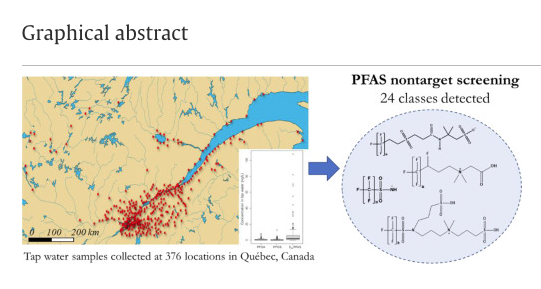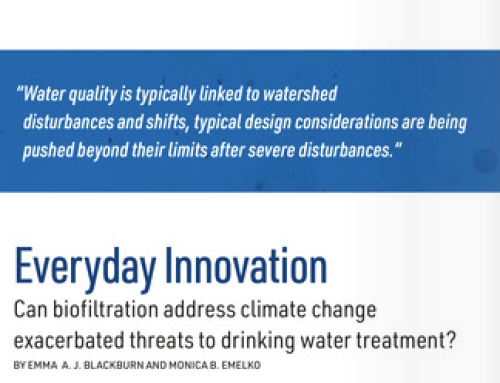
Hi all…for those of you interested in PFAS from a Canadian perspective an article entitled “Target and Nontarget Screening of PFAS in Drinking Water for a Large-Scale Survey of Urban and Rural Communities in Québec, Canada” has just appeared in the journal ‘Water Research’. Tap water samples were analyzed for 42 PFAS in 376 municipalities within 17 administrative regions in Quebec and it was found that 99.3% of the tap water samples were positive for at least one PFAS. In addition, “target and nontarget analysis revealed 24 PFAS classes (54 homologs) in tap water.” There is a substantial amount of information that can be gleaned from this screening, for example, comparisons of drinking water produced from groundwater and surface water, discussion of concentrations found vs guidelines/advisories/regulations, impact of pH, methods, etc.
Health Canada’s recently proposed draft objective which is targeting an objective of 30 ng/L for the sum of total per- and polyfluoroalkyl substances (PFAS) in drinking water is mentioned. Note that the Health Canada ‘sum’ refers to the 18 PFAS included in USEPA Methods 533 or 537.1 (vs the 42 surveyed here). Based on this target objective value, the authors report that they found “ten samples from 5 different localities that exceed the proposed 30 ng/L threshold” (using the 18 PFAS).
Bill
_______________________________________________________________________
Target and Nontarget Screening of PFAS in Drinking Water for a Large-Scale Survey of Urban and Rural Communities in Québec, Canada
Gabriel Munoz, Min Liu, Sung Vo Duy, Jinxia Liu, Sébastien Sauvé
Water Research Available online 16 February 2023, 119750 In Press, Journal Pre-proof
ABSTRACT
“Limited monitoring data are available regarding the occurrence of emerging per- and polyfluoroalkyl substances (PFAS) in drinking water. Here, we validated an analytical procedure for 42 PFAS with individual detection limits of 0.001-0.082 ng/L. We also evaluated how different sample pH conditions, dechlorinating agents, and storage holding times might affect method performance. PFAS were analyzed in tap water samples collected at a large spatial scale in Quebec, Canada, covering 376 municipalities within 17 administrative regions. Target and nontarget screening revealed the presence of 31 and 23 compounds, respectively, representing 24 homolog classes. Overall, 99.3% of the tap water samples were positive for at least one PFAS, and the ƩPFAS ranged from below detection limits to 108 ng/L (95th percentile: 13 ng/L). On average, ƩPFAS was 12 times higher in tap water produced from surface water than groundwater; however, 6 of the top 10 contaminated locations were groundwater-based. Perfluorooctanoic acid (PFOA) and perfluorooctane sulfonate (PFOS) had high detection rates (88% and 80%, respectively). PFOS (median: 0.15 ng/L; max: 13 ng/L) and PFOA (median: 0.27 ng/L; max: 8.1 ng/L) remained much lower than current Health Canada guidelines but higher than USEPA’s interim updated health advisories. Short-chain (C3-C6) perfluoroalkyl sulfonamides were also recurrent, especially the C4 homolog (FBSA: detection rate of 50%). The 6:2 fluorotelomer sulfonyl propanoamido dimethyl ethyl sulfonate (6:2 FTSO2PrAd-DiMeEtS) was locally detected at ∼15 ng/L and recurred in 8% of our samples. Multiple PFAS that are most likely to originate from aqueous film-forming foams were also reported for the first time in tap water, including X:3 and X:1:2 fluorotelomer betaines, hydroxylated X:2 fluorotelomer sulfonates, N-trimethylammoniopropyl perfluoroalkane sulfonamides (TAmPr-FHxSA and TAmPr-FOSA), and N-sulfopropyl dimethylammoniopropyl perfluoroalkane sulfonamidopropyl sulfonates (N-SPAmP-FPeSAPS and N-SPAmP-FHxSAPS).”





